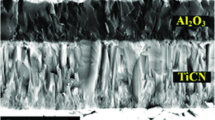Abstract
Cutting fluids play a significant role in machining operations, impact shop productivity, tool life and quality of work. The reduction in the consumption rate of the cutting fluid leads to the minimization of production cost and environmental hazards. This could be achieved by the enhancement of its thermal and tribological properties with the inclusion of suitable additives in the cutting fluid. In recent years various nanoparticles were used as additives in the conventional cutting fluid to enhance its properties. In the present work, silver nanoparticles was synthesized, characterized, dispersed in cutting fluid and experimented in a turning operation. Heat carrying capacities of the cutting fluid, cutting forces during machining process and surface finish of the work piece were assessed by suitable instruments for cutting fluids with and without silver nanoparticles under different machining conditions. From the experimental results, it was observed that inclusion of silver nanoparticles in cutting fluid showed a significant reduction in tool tip temperature, cutting force and surface roughness of the work piece.
Similar content being viewed by others
References
M. A. El Baradie, Cutting fluids: Part I. Characterisation, Journal of materials processing technology, 56 (1996) 786–797.
M. A. El Baradie, Cutting fluids: Part II. Recycling and clean machining, Journal of materials processing technology, 56 (1996) 798–806.
S. U. S. Choi, Z. G. Zhang, W. Yu, F. E. Lockwood and E. A. Grulke, Anomalous thermal conductivity enhancement in nano-tube suspensions, Applied Physics Letters, 79 (2001) 2252–2254.
J. A. Eastman, S. U. S. Choi, S. Li, W. Yu and L. J. Thompson, Anomalously increased effective thermal conductivities of ethylene glycol-based nanofluids containing copper nanoparticles, Applied Physics Letters, 78(6) (2001) 718–720.
Ramakrishna N. Hedge, Srikanth S. Rao and R. P. Reddy, Experimental study on CuO nanoparticles in distilled water and its effect on heat transfer on a vertical surface, Journal of Mechanical Science and Technology, 25(11) (2011) 2927–2934.
P. C. Mukesh Kumar, J. Kumar and S. Suresh, Experimental investigation on convective heat transfer and friction factor in a helically coiled tube with Al2O3 / water nanofluid, Journal of Mechanical Science and Technology, 27(1) (2013) 239–245.
B. Shen, A. Shih and S. C. Tung, Application of nanofluids in minimum quantity lubrication grinding, Tribology & Lubrication Technology, 51 (2008) 730–737.
B. Shen and A. Shih, Performance of novel mos2 nanoparticles based grinding fluids in minimum quantity lubrication grinding, Transactions of NAMRI/SME, 36 (2008) 357–364.
P. H. Lee, Jung Soo Nam, Chengjun Li and Sang Won Lee, An experimental study on micro-grinding process with nanofluid minimum quantity lubrication (MQL), International Journal of Precision Engineering and Manufacturing, 13 (2012) 331–338.
Jung Soo Nam, Pil-Ho Leea and Sang Won Lee, Experimental characterization of micro-drilling process using nanofluid minimum quantity lubrication, International Journal of Machine Tools and Manufacture, 51 (2011) 649–652.
U. Sridharan and S. Makin, Effect of minimum quantity lubrication (MQL) with nanofluids on grinding behaviour and thermal distortion, Transactions of NAMRI/SME, 37 (2009) 629–636.
D. Nageswara Rao, R. R. Srikant, P. Vamsi Krishna and M. S. Subrahmanyam, Applicability of cutting fluids with nanoparticles inclusion in machining, Journal of Engineering Tribology, 223 (2009) 221–225.
Shung-Wen Kang, Wei-Chiang Wei, Sheng-Hong Tsai and Shih-Yu Yang, Experimental investigation of silver nanofluid on heat pipe thermal performance, Applied Thermal Engineering, 26 (2006) 2377–2382.
Yu-tang Chen, Experimental study of silver nanofluid on flat heat pipe thermal performance, Journal of Marine Science and Technology, 18(5) (2010) 731–734.
E. Pradeep Jaya Sudhan and K. Shree Meenakshi, Synthesis of silver nanofluid by a novel one pot method for heat transfer applications, Indian Journal of Science and Technology, 4 (2011) 417–421.
Asta sileikaite, igoris prosycevas, judita puiso, algimantas juraitis and asta guobiene, Analysis of silver nanoparticles produced by chemical reduction of silver salt solution, Materials Science, 12 (2006) 287–291.
Jong-Seok Kim, Reduction of silver nitrate in ethanol by poly (N-vinylpyrrolidone), Journal of Industrial and Engineering Chemistry, 13 (2007) 566–570.
M. M. Kholoud, Abou El-Nour, Ala’a Eftaiha, Abdurrahman Al-Warthan and Reda A. A. Ammar, Synthesis and applications of silver nanoparticles, Arabian Journal of Chemistry, 3 (2010) 135–140.
Ki Chang Song, Sung Min Lee, Tae Sun Park and Bum Suk Lee, Preparation of colloidal silver nanoparticles by chemical reduction method, Korean J. Chem. Eng, 26 (2009) 153–155.
Sally D. Solomon, Mozghan Bahadory, Aravindan V. Jeyarajasingam, Susan A. Rutkowsky and Charles Boritz, Synthesis and study of silver nanoparticles, Journal of Chemical Education, 84 (2007) 322–325.
Jung-Yeul Jung, Changhwan Cho, Wook Hyun Lee and Yong Tae Kang, Thermal conductivity measurement and characterization of binary nanofluids, International Journal of Heat and Mass Transfer, 54 (2011) 1728–1733.
K. C. Leong, C. Yang and S. M. S. Murshed, A model for the thermal conductivity of nanofluids — the effect of interfacial layer, Journal of Nanoparticle Research, 8 (2006) 245–254.
Junemoo Koo and Clement Kleinstreuer, A new thermal conductivity model for nanofluids, Journal of Nanoparticle Research, 6 (2004) 577–588.
Author information
Authors and Affiliations
Corresponding author
Additional information
Recommended by Associate Editor Haseung Chung
N. Saravanakumar received his Ph.D. from Anna University, Chennai in the year 2008. He is currently working as Associate professor in the department of Mechanical engineering, PSG College of technology, Tamilnadu, India. His research area includes metal forming, Tribology, shape memory alloys.
L. Prabu received his master’s degree in computer aided design from Anna University, Chennai in the year 2007. Currently working as Assistant professor in Sri Eshwar College of engineering, Tamilnadu, India. He is doing his research work in the Nano-cutting fluid.
M. Karthik received his PGDM from Indian Institute of Management, Tamilnadu, India. Currently working as Assistant manager in BPCL, India.
A. Rajamanickam, received his Bachelor degree in Mechanical Engineering from PSG College of Technology, Tamilnadu, India. Currently working as Design engineer in Tata consultancy services, India.
Rights and permissions
About this article
Cite this article
Saravanakumar, N., Prabu, L., Karthik, M. et al. Experimental analysis on cutting fluid dispersed with silver nano particles. J Mech Sci Technol 28, 645–651 (2014). https://doi.org/10.1007/s12206-013-1192-6
Received:
Revised:
Accepted:
Published:
Issue Date:
DOI: https://doi.org/10.1007/s12206-013-1192-6




